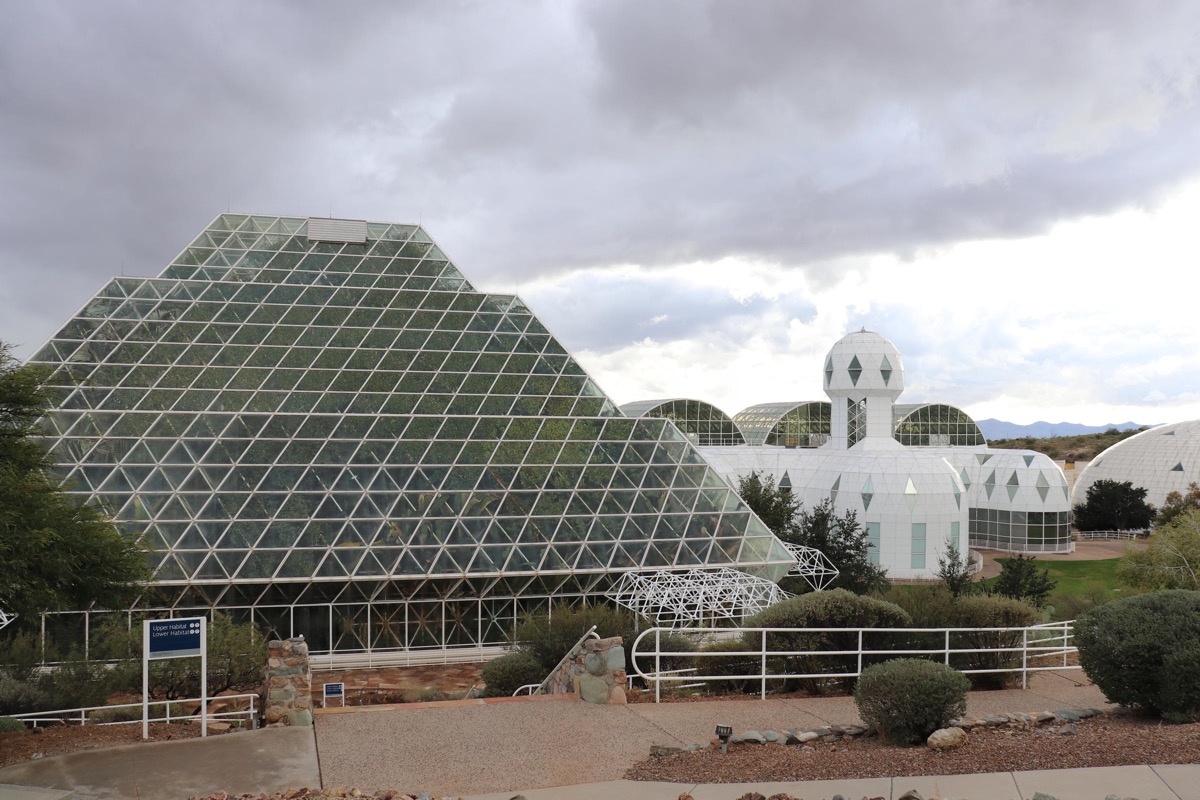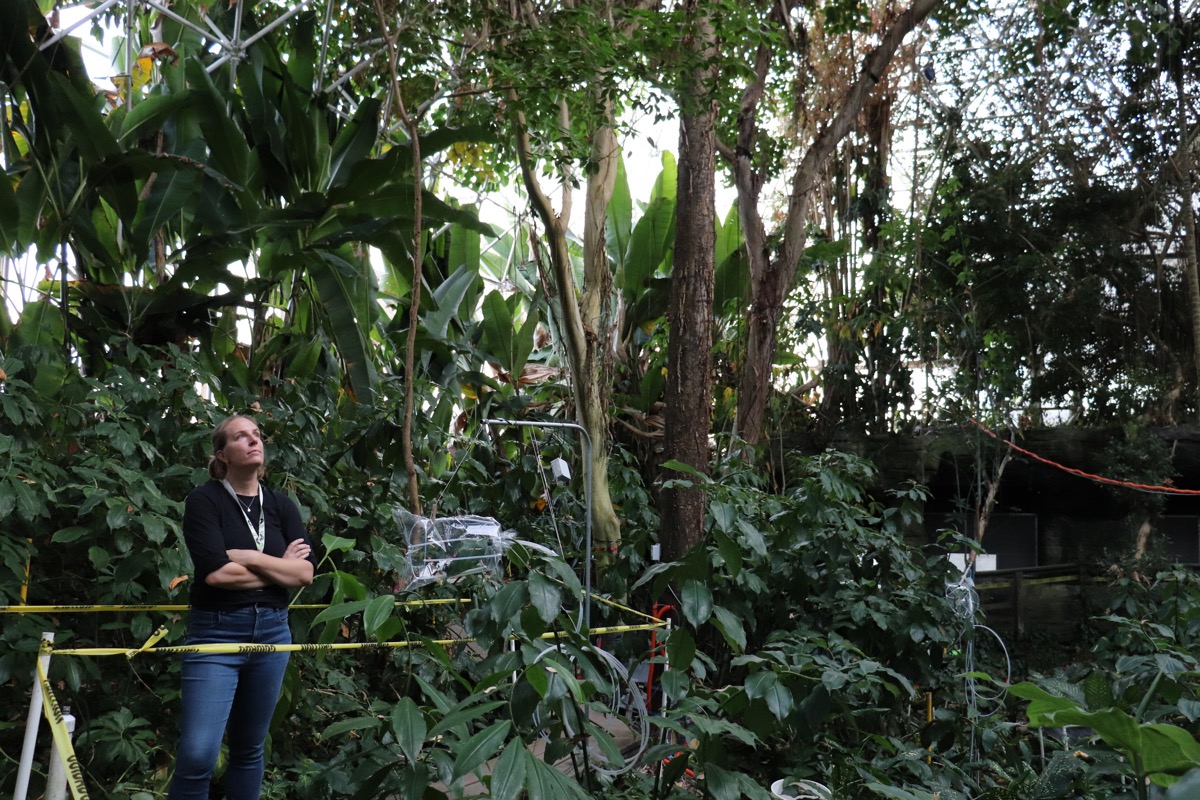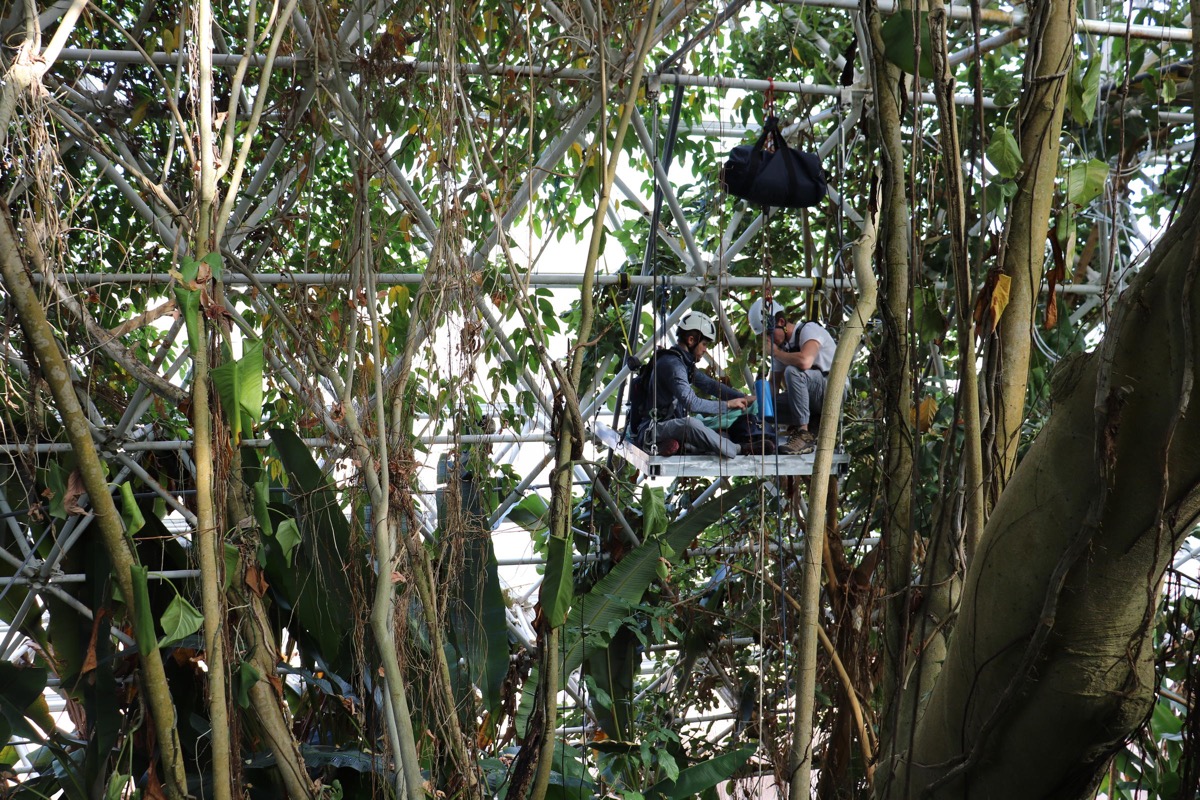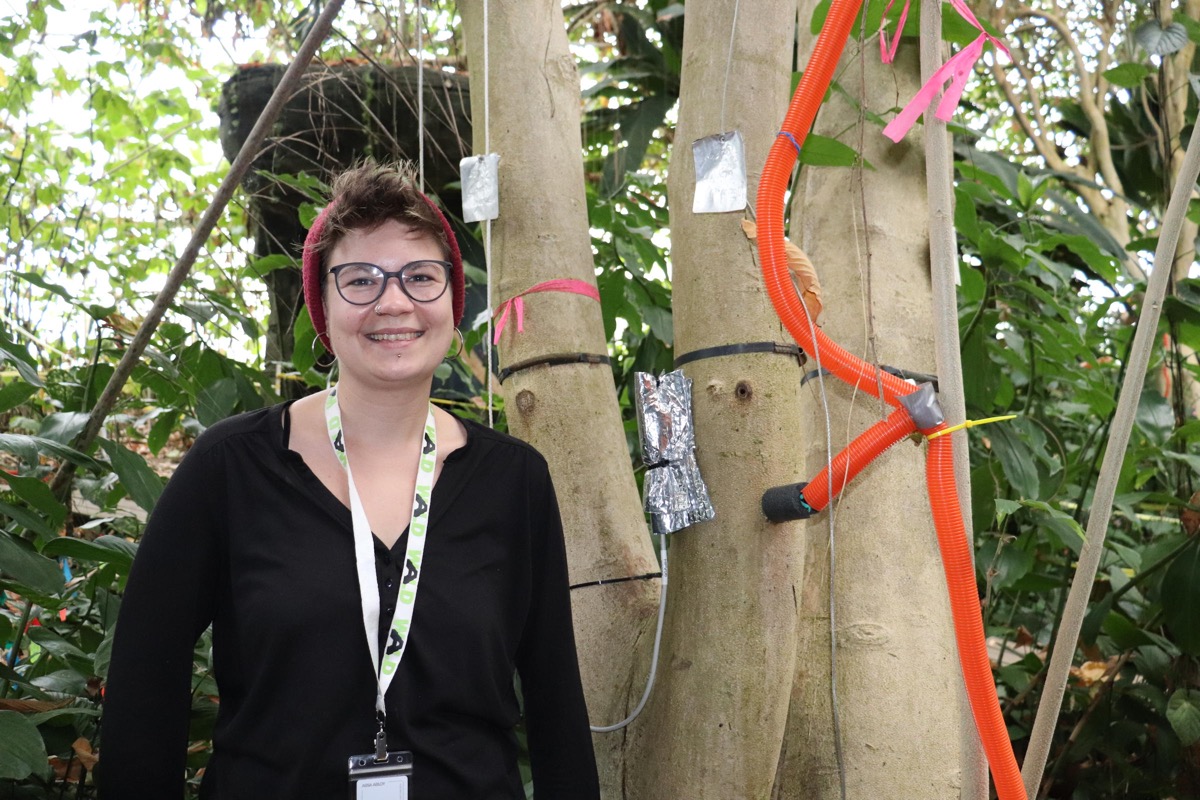Studying Drought, Under Glass
4:01 minutes

 This segment is part of The State of Science, a series featuring science stories from public radio stations across the United States. This story by Melissa Sevigny appeared on KNAU.
This segment is part of The State of Science, a series featuring science stories from public radio stations across the United States. This story by Melissa Sevigny appeared on KNAU.
The world’s hottest rainforest isn’t the Amazon. It’s not even in the tropics. It’s kept under glass in the desert of Southern Arizona. Biosphere 2, operated by the University of Arizona, was built 30 years ago as an experiment in space colonization, but now the ecosystems inside are perfect for climate change research. Unlike in the real world, scientists can control the elements—which is just what they did when they turned off the rain for two months. They’re tracking how carbon cycles through the enclosed rainforest during the drought. KNAU’s Melissa Sevigny reports, it’s a glimpse of what the world will look like in a hotter, drier future.
Christiane Werner of the University of Freiberg in Germany lines up a row of steel canisters on a table. She’s about to release twenty thousand dollars’ worth of carbon dioxide into the air.
“Why can you do it here? Because we are in an enclosed ecosystem,” she says.
In a real rainforest it’s impossible to track carbon cycles closely, but this forest is sealed inside a gymnasium-sized pyramid of steel and glass. Werner opens a valve and a puff of air escapes. This is “heavy” carbon or carbon-13. It’s manufactured so instruments can detect it. Werner says, “We can really make the carbon flow through a system visible with this technique, and that’s why it’s so exciting.”

Scientists know forests soak up about a third of carbon emissions from fossil fuels, but they don’t know exactly where that carbon goes—or how it’s affected by drought.
Laura Meredith, director of rainforest research at Biosphere 2, wants to find out if ecosystems will respond to droughts in a way that releases carbon and worsens climate change, “or in a way that actually helps mitigate it, helps slow down the process. Maybe they have some mechanisms that allow them to be very resilient and to absorb those changes.”
It’s a massive experiment with more than 80 scientists from 13 institutions, funded by a 2 million dollar grant from the European Research Council.
Inside the Biosphere 2’s rainforest is a hollowed-out mountain buzzing with scientific instruments. A spiderweb of plastic tubes links about 20 gas analyzers to every part of the rainforest. “The plants look a little bit like they’re hospitalized with all of the sensors, too,” Meredith says. “We have sap flow sensors, water storage sensors.”
The team even had to hire climbers to scale the top of the glass dome and hook sensors onto individual leaves. Jana U’Ren, a biosystems engineer at the University of Arizona, says, “We had to order 20 bags of—like turkey bags that you’d normally cook your Thanksgiving turkey in, and we made little enclosures for leaves.” That’s to figure out how plants “spend” their carbon when they’re stressed: do they store it in roots and leaves, give it away to microbes, or breathe it back into the air as a kind of coping mechanism?


Joost van Haren is an earth scientist at the University of Arizona. “It’s this resilience that trees have which is so super cool,” he says. “Because of many ways that trees are so different from us humans, we really don’t grasp that kind of resilience just yet.”
The scientists will collect almost a petabyte of data, says cyber infrastructure expert Bonnie Hurwitz. That’s like a book with five hundred billion pages. She says, “Everything is wired and linked up, streaming to the cloud, and it gives us an opportunity unlike any other ecosystem where we have both the technology and science in place to really measure and monitor these global processes that are impossible to do in the field.”
The idea is to build better models of how ecosystems work. The scientists say those predictions will be crucial as real rainforests begin to heat up. John Adams, deputy director of Biosphere 2, says it was built by people who dreamed of going to other planets, but now it’s about protecting our own.
“There is only one Earth,” Adams says. “Everything had to come together to make it a suitable atmosphere and conditions for you and I to survive, and you just don’t find that anywhere else.”
Today the team turns the rain back on and they’ll study the rainforest as it recovers.
Invest in quality science journalism by making a donation to Science Friday.
Melissa Sevigny is a science reporter at KNAU in Flagstaff, Arizona.
IRA FLATOW: Time now to check in on the state of science.
SPEAKER 1: This is KER–
SPEAKER 2: For WWNO–
SPEAKER 3: St. Louis Public Radio–
SPEAKER 4: Iowa Public Radio News.
IRA FLATOW: Local science stories of national significance. With climate change shifting weather patterns around the world and fires continuing to rage in Australia and the Amazon, the question of how carbon gets stored, used, and released in the environment is getting more attention. Researchers from over 80 institutions are collaborating on a project to track how the carbon flows in a rainforest under drought condition and as it recovers. But it’s not happening down in the Amazon, it’s happening in Arizona.
You know the enclosed dome of the Biosphere 2 habitat? They’re letting researchers use things like carbon 13 labeled CO2 to follow the flow of carbon through the air, the plants, and the soil. Joining me now to talk about the project is Melissa Sevigny, science reporter at KNAU in Flagstaff. Welcome to Science Friday.
MELISSA SEVIGNY: Thanks for having me.
IRA FLATOW: So tell us about this project. What is going on there and in Biosphere 2?
MELISSA SEVIGNY: Right, so one of the cool things about an enclosed ecosystem like the Biosphere 2 is that you can control the weather, so scientists decided, why not turn off the rain for two months and force this rainforest to go through a drought. And one of the big questions they have is what the plants are going to do with their carbon when they’re stressed out. So we know that forests soak up a huge amount of carbon, but we don’t know exactly where that carbon goes, and that’s because in the real world, you just can’t track carbon cycles that closely.
But the great thing about the Biosphere 2 is that it’s a sealed ecosystem. So one of the experiments the scientists did is they closed all of the doors and they shut themselves inside for four hours, and I got to be in there with them, it was a great deal of fun, and they released canisters of carbon 13 into the air. That’s heavy carbon and it’s something they can track way scientific instruments. And then they had these instruments hooked up to every part of the rainforest to see exactly where those carbon molecules ended up.
IRA FLATOW: And so they could follow the carbon cycle, as we call it?
MELISSA SEVIGNY: Right, exactly. And so it’s a pretty cool setup. Inside the rainforest is this fake hollow mountain, and inside that mountain is a room that was filled with very precise scientific instruments, and there was this spider web of plastic tubing that connected those instruments to every part of the rainforest. It was something like 2 miles of tubes, and they were constantly collecting gas samples from different parts of the rainforest and figuring out where the carbon was going. So just as one example that was pretty neat, they wanted to look at individual leaves, so they wrapped up leaves in these Teflon bags and hooked them up to the instruments so they could see, maybe the leaves are getting stressed out and they’re releasing more carbon into the atmosphere, and they could look at that very closely.
IRA FLATOW: So how long will this experiment run? And will they keep tweaking up the CO2 levels to sort of mimic what’s going to be going on in the atmosphere?
MELISSA SEVIGNY: Right, so the experiment– the drought itself was two months, and they ended that drought in December, and it’s pretty important to track the recovery of the plants after the drought ends, so they’re going to keep collecting data for the next month or two and watch how the plants recover.
IRA FLATOW: It’s interesting, because people are wondering, what’s the best use for Biosphere 2, and now it looks like we have found something really useful.
MELISSA SEVIGNY: Right. Right, yeah. I don’t think anyone could have predicted that. Certainly, 30 years ago, it wasn’t built specifically for this type of research, but it turns out to be a really useful place.
If you’re studying climate change, and you’re looking at ecosystems in the real world, they’re very complicated and it’s super hard to control all of the variables, but if you’re just looking at like, a potted plant or a greenhouse, well, that’s pretty small, and you’re not really getting the complete picture. So this rainforest is the size of a gymnasium. It’s been living and thriving for 30 years. It’s the perfect place to do this kind of research.
IRA FLATOW: And you got a chance to go in there. Melissa, thank you very much for telling us what it’s like.
MELISSA SEVIGNY: Thanks so much.
IRA FLATOW: Melissa Sevigny is a science reporter at KNAU in Flagstaff.
Copyright © 2020 Science Friday Initiative. All rights reserved. Science Friday transcripts are produced on a tight deadline by 3Play Media. Fidelity to the original aired/published audio or video file might vary, and text might be updated or amended in the future. For the authoritative record of Science Friday’s programming, please visit the original aired/published recording. For terms of use and more information, visit our policies pages at http://www.sciencefriday.com/about/policies/
As Science Friday’s director and senior producer, Charles Bergquist channels the chaos of a live production studio into something sounding like a radio program. Favorite topics include planetary sciences, chemistry, materials, and shiny things with blinking lights.
Ira Flatow is the founder and host of Science Friday. His green thumb has revived many an office plant at death’s door.